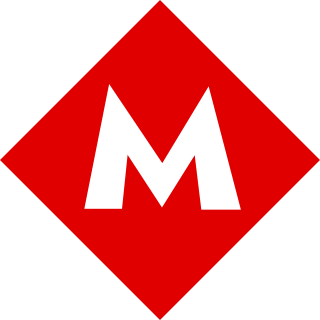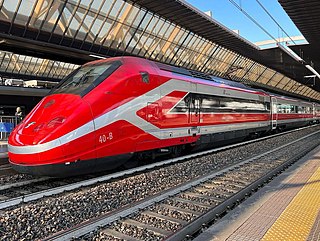
Railway electrification is the use of electric power for the propulsion of rail transport. Electric railways use either electric locomotives, electric multiple units or both. Electricity is typically generated in large and relatively efficient generating stations, transmitted to the railway network and distributed to the trains. Some electric railways have their own dedicated generating stations and transmission lines, but most purchase power from an electric utility. The railway usually provides its own distribution lines, switches, and transformers.

The Ankara Metro is the rapid transit system serving Ankara, the capital of Turkey. At present, Ankara's rapid transit system consists of two metro lines – the Batıkent Metrosu (M1) and the new Keçiören Metrosu (M4) line opened in 2017, along with the Ankaray line. The Ankaray, the M1 and M4 lines, together transported 104.1 million passengers in 2014. That corresponds to a ridership of approximately 289,155 per day. In February 2019 all the lines that used to run M1, M2 and M3 were merged to create one line, M1.
Hitachi Rail Italy S.p.A. is a multinational rolling stock manufacturer company based in Pistoia, Italy. Formerly AnsaldoBreda S.p.A., a subsidiary of state-owned Finmeccanica, the company was sold in 2015 to Hitachi Rail of Japan. After the deal was finalized, the current name was adapted in November 2015 to reflect the new ownership.

Line 1 is the first underground rapid transit line built in Milan, Italy. It is part of the Milan Metro and it is operated by ATM. Works on the line began in 1957, and the first part was opened on 1 November 1964, running from Sesto Marelli to Lotto station. The line is also called Red Line, as it is visually identified by red signs. Due to its premiership, the line gave its red color to the Milan Metro logo.

Line 3 is a subway line serving Milan, Italy. The line is part of the Milan Metro and is operated by ATM. Construction began in 1981 in order to be ready for the 1990 Football World Cup. It is also called the Yellow Line as it is identified by yellow signage.

The City Circle Line or M3 is a loop line of the Copenhagen Metro. It has been claimed by COWI A/S that the City Circle Line is the largest construction project to have taken place in Copenhagen during the last 400 years. The network's total length is 15.5 kilometres (9.6 mi) and has 17 stations. The line opened on 29 September 2019.

The IC4 is an inter-city rail train built by the Italian train manufacturer AnsaldoBreda for the trans-Great Belt routes of Danske Statsbaner (DSB), Denmark's national railway operator. Under DSB's 'Good trains for everyone' plan, the intent of the IC4 project was to replace several types of outdated rolling stock. However, various delays and shortcomings have turned the project into a major political issue.

The HŽ series 1061 was a 6-axle articulated electric locomotive series that was used by Croatian Railways. In Slovenia it is known as SŽ series 362. This locomotive, built jointly by Ansaldo and Breda, is derived from the Italian FS Class E636 and was originally donated by the Italian government. It was known as JŽ series 362 in the SFRJ. It was mostly used on the Rijeka - Zagreb railway and some auxiliary branches of this line. With the conversion of the Rijeka - Zagreb railway from 3KV DC electrical system to the 25 KV AC catenary, these locomotives were retired in 2012. Almost identical locomotives of this type on the Slovenian Railways were phased out in 2008.

The Brescia Metro is a rapid transit network serving Brescia, Lombardy, Italy. The network consists of a single line, having a length of 13.7 kilometres (8.5 mi) and a total of 17 stations from Prealpino to Sant’Eufemia-Buffalora, located respectively at the north and southeast of Brescia.

SL95 is a series of 32 low-floor, articulated trams operated on the Oslo Tramway. The series was built by Italian rail manufacturer Ansaldo/Firema, later known as AnsaldoBreda, and delivered between 1999 and 2004. Capacity for the eight-axle, three-section vehicles is 212 passengers, of which 88 can be seated. The name derives from being ordered in 1995. Original plans called for the delivery to be between 1997 and 1998. Delivery took many years due to a magnitude of technical flaws, including high noise levels, freezing during the winter and corrosion. The trams are 33.12 metres long, 2.6 metres wide and 3.62 metres tall. The aluminum vehicles weigh 64.98 tonnes and have a power output of 840 kilowatts (1,130 hp).

Stadler FLIRT is a passenger multiple unit trainset made by Stadler Rail of Switzerland. The baseline design of FLIRT is an electric multiple unit articulated trainset that can come in units of two to twelve cars with two to six motorized axles. The maximum speed is 200 km/h (125 mph). Standard floor height is 57 cm, but 78 cm high floors are also available for platform heights of 76 cm.

The A650 is an electric multiple unit rapid transit car built for use on the Los Angeles Metro Rail system. The cars were manufactured by the Italian company Breda at its Pistoia plant in Italy between 1988 and 1997 and are used on the Metro B and D Lines.

The Trenitalia ETR 700, originally NS Hispeed V250, is a high-speed train designed by Pininfarina and built by AnsaldoBreda originally for NS International and NMBS/SNCB to operate on the Fyra service, a high speed train between Amsterdam and Brussels with a branch to Breda on the newly built HSL-Zuid in the Netherlands and its extension HSL 4 in Belgium.
Hitachi Rail STS SpA or Hitachi Rail STS is a transportation company owned by Hitachi with a global presence in the field of railway signalling and integrated transport systems for passenger traffic and freight operations. Hitachi Rail STS plans, designs, manufactures, installs and commissions signaling systems, components and technologies for the management and control of newly built or upgraded railways, transit and freight lines worldwide.

The Hitachi Rail Italy Driverless Metro is a class of driverless electric multiple units and corresponding signaling system. Manufactured by Hitachi Rail Italy and Hitachi Rail STS in Italy, it is or will be used on the Copenhagen Metro, a people mover at Princess Nourah Bint Abdul Rahman University, the Brescia Metro, the Thessaloniki Metro, lines 4 and 5 of the Milan Metro, Line C of the Rome Metro, Skyline in Honolulu, and the Circular line of the New Taipei Metro. The first system to use this class of driverless electric multiple units was the Copenhagen Metro which was opened in 2002.

Line 5 is an underground rapid transit line in Milan, Italy, part of the Milan Metro. The line, also known as M5 or the Lilac Line, is 12.8-kilometre (8.0 mi) long and goes through the city from the north to the north-west. It opened in stages between 2013 and 2015.

ETR 500 is a family of Italian high-speed trains built by AnsaldoBreda and introduced in 1993.

The Frecciarossa 1000 is a high-speed train operated by Italian state railway operator Trenitalia and the private Spanish high-speed rail operator Iryo. It was co-developed as a joint venture between Italian rail manufacturer Hitachi Rail Italy and multinational conglomerate Alstom. Both design and production work were divided between the two partner companies.

The ALe 582 is an Italian electric multiple unit train designed for commuter and medium-distance services, developed in the mid-1980s to replace pre-war and immediately post-war EMUs and locomotive-hauled trains on various lines in Sicily and Southern Italy, although they later diffused on the whole FS network. They're part of the "ALe Elettroniche" or "G.A.I." family, together with their predecessors ALe 724 and their successors, the ALe 642.

The New Taipei Metro Circular Line EMU is a medium-capacity train operating on Taipei Metro's Circular line. A total of 17 4-car trains were manufactured by Hitachi Rail Italy in Reggio Calabria, then shipped to Hsinchu for final assembly at Taiwan Rolling Stock Company (TRSC). This is the second time Taiwan has purchased trains made in Italy after Taiwan Railways' EMU300 series, built by Socimi.



















